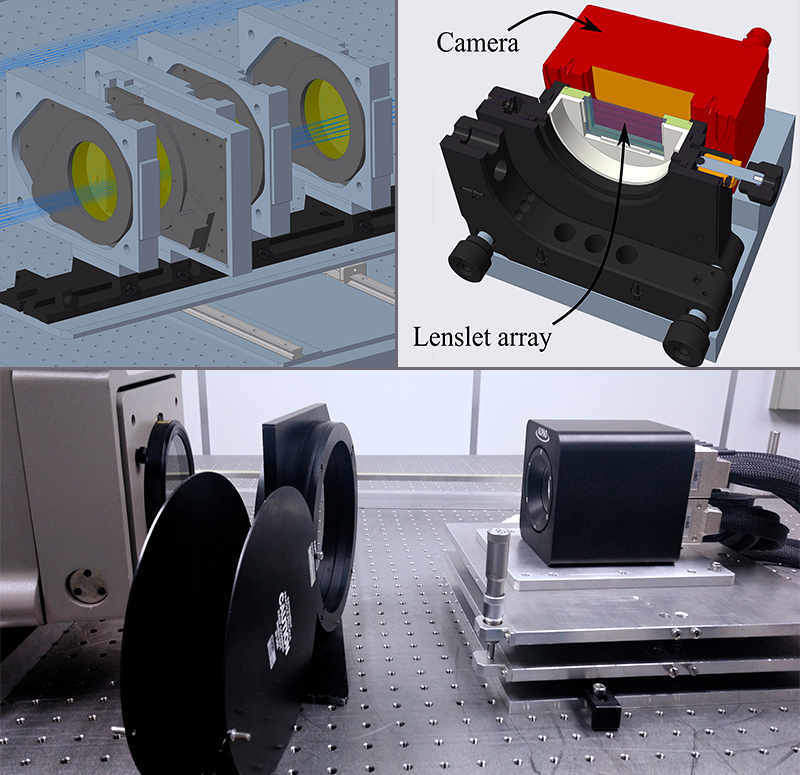The ideal MCAO system for EST has five mirrors, a corrected field of view of 1 arcminute, and a Strehl ratio of 40% at all telescope elevation angles. A very demanding configuration derived from simulations that is now going to be tested in the laboratory.
 Top: Conceptual designs of the turbulence simulator and the wavefront sensor. Bottom: EST MCAO testbed
Top: Conceptual designs of the turbulence simulator and the wavefront sensor. Bottom: EST MCAO testbed
Adaptive optics is a relatively new technology. Although comprehensive experiments and studies started in the 1970s, it wasn’t until the 1990s that the first systems were installed in nighttime telescopes.
However, conventional AO systems have some limitations when it comes to solar physics: correcting image degradation in visible wavelengths, where most solar observations are conducted, is more challenging than in the infrared.
Even more, the quality of the correction decreases as the separation from the centre of the image increases. Although this is also an issue for nighttime astronomy, there are some cases where a a small field of view suffices (after all, distant stars are akin to a point source). However, small fields of view are always a problem for solar astronomy, where the regions of interest can have very large dimensions.
EST is aiming to overcome those limitations by using a Multi-Conjugated Adaptive Optics (MCAO) system “to achieve a field of view of 1 arcminute and the best possible optical quality”, lays out Luzma Montoya, from the Instituto de Astrofísica de Canarias, one of the engineers working on the EST MCAO development.
Numerical simulations… and a testbed to optimise them
Numerical simulations indicate that, in order to achieve those parameters, the ideal EST MCAO should have five deformable mirrors conjugated at 0, 5, 9, 12 and 20 km (turbulence above 20 km is almost inappreciable). A very good result could be achieved with 4 deformable mirrors for low elevation angles and 3 for high elevations. However, the best results would be obtained with five mirrors.
Simulations are just that, so the engineers at EST are now building an MCAO testbed to verify their results in the laboratory. Smaller than the final design, the testbed -that is set to be finished by February 2021- will nevertheless be impressive: it will have three deformable mirrors and three types of wavefront sensors.
The testbed will create a high resolution image of the solar surface that will then be perturbed by a turbulence simulator (that can emulate a vertical profile with five tuneable altitudes). Given that the initial image and the turbulence will be known, the testbed will make it easier to evaluate the best configurations to add to the final design (testbed and design are working in parallel).
Three Shack-Hartmann correlation wavefront sensors will be implemented in the testbed, allowing to decide the best strategy and configuration for the final MCAO system.
Also, two different types of wavefront sensing will be tested: correlation Shark-Hartmann wavefront sensing with standard AO reconstruction methods, and wavefront sensing based on artificial neural networks (neural networks are a very novel approach to adaptive optics and this is one of the first attempts of using them in solar telescopes).
More information
- MCAO testbed configuration. EST Newsletter 6
- Montoya, L., Montilla, I., Collados, M. "MCAO numerical simulations for EST: analysis and parameter optimization", AO4ELT4 (2015)
- Montilla, I., Montoya, L., "The MCAO system of the EST: DM heigh determination for best performance using real daytime statistical turbulence data", AO4ELT5 (2017), paper 167.
- Rimmele, T. R., & Marino, J. (2011). Solar Adaptive Optics. Living Reviews in Solar Physics, 8, 2.
